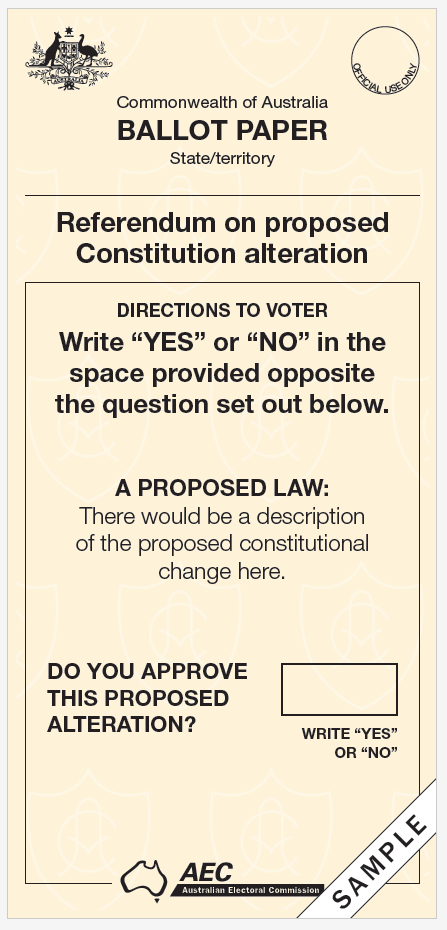This week, we consider the purpose, powers and wording of the Voice legislation. We will also look at Indigenous advocacy bodies around the world to provide context and comparisons for what is being suggested in Australia.
Constitutional Amendment
The proposed text that voters are being asked to approve reads:
Chapter IX Recognition of Aboriginal and Torres Strait Islander Peoples
129 Aboriginal and Torres Strait Islander Voice
In recognition of Aboriginal and Torres Strait Islander peoples as the First Peoples of Australia:
- There shall be a body, to be called the Aboriginal and Torres Strait Islander Voice;
- The Aboriginal and Torres Strait Islander Voice may make representations to the Parliament and the Executive Government of the Commonwealth on matters relating to Aboriginal and Torres Strait Islander peoples;
- The Parliament shall, subject to this Constitution, have power to make laws with respect to matters relating to the Aboriginal and Torres Strait Islander Voice, including its composition, functions, powers and procedures.[1]
If approved this law would be inserted as a new section at the end of the Constitution. The purpose of the alteration is threefold:
- to recognise Aboriginal and Torres Strait Islander peoples as the First Peoples of Australia;
- to establish the Voice as an advisory body;
- to give Parliament the power to pass legislation related to the Voice, including the structure of the Voice.
Whilst including the Voice in the Constitution means that it cannot be dismantled, the third point ensures that over time Parliament can still change the composition, functions, powers and procedures of the Voice.

The ballot paper handed to us at polling booths on 14 October 2023 will have the question:
A Proposed Law: to alter the Constitution to recognise the First Peoples of Australia by establishing an Aboriginal and Torres Strait Islander Voice.
Do you approve this proposed alteration?[2]
To which voters simply write Yes or No in the box on the paper.
Some examples of Indigenous Voices to Parliament
Many governments around the world engage with the Indigenous peoples of their countries and have been doing so for decades. Indigenous and minority voices in India, South Africa and the USA use a range of systems in order to engage in government decisions.[3] In Canada, there is the Assembly of First Nations (AFN). This is an advocacy organisation that runs in a similar way to the United Nations through fulfilling mandates through resolutions. The mandates cover a range of policy areas including health, economies, the environment, education, languages, water, social development and infrastructure. The AFN ‘seeks to advance First Nations Inherent and Treaty Rights through the development policy, public education and, where applicable, the co-development of legislation to build First Nations capacity.’[4]
The Sami people are the Indigenous people of Norway, Sweden, Finland and Russia’s Kola Peninsula. Norway, Sweden and Finland each have their own Sami parliament and, with the Russian Sami people, all four are represented on the Sami Parliamentary Council, the co-operative body for the Sami Parliaments.[5] There are differences between the three Sami Parliaments and how they interact with their national governments, but also key similarities. All are consultative bodies established to promote and preserve cultural self-determination, including language, traditional livelihood (such as reindeer herding), land rights and social wellbeing.[6]
New Zealand incorporates Indigenous voices directly into parliamentary decision-making. From 1867, there have been designated Māori seats in the New Zealand Parliament.[7] Under this system today, seven representatives are elected from the seven Māori electorates. These electorates cover vast distances and only those on the Māori electoral roll can vote for these candidates. In New Zealand there are also some policy areas that give the decision-making power to community. One example of this is Whānau Ora (loosely translated as ‘extended family’). In order to achieve better health, education, housing, skills development and economic outcomes, Māori communities are empowered to run community-driven development models.[8] The Ministry of Māori Development has found that these systems provide trust, tailored programs and better outcomes.
The Australian story – how did we get here?
Given all these different systems and their varying degrees of success, how did the Albanese government decide on a Voice to Parliament system? A Voice to Parliament was the recommendation of the extensive consultations done with First Nations peoples in Australia over the past ten years. The most recent of these was the Indigenous Voice co-design process that began in 2019.[9] From January 2021, the co-design members led a public consultation process both in person and online.
A Voice to Parliament has been suggested as the next step in the reconciliation process by the Uluru Statement from the Heart. It is based on a series of design principles that have been agreed upon by the First Nations Referendum Working group.[10] Whilst the design of the Voice will be decided by Parliament after the referendum, the principles set out the importance of inclusivity, community consultation and the limits by which the Voice would be restricted.
Join us next week as we have a closer look at the arguments of the Yes and No campaigns.
[1] National Indigenous Australians Agency, https://www.niaa.gov.au/indigenous-affairs/referendum-aboriginal-and-torres-strait-islander-voice.
[2] Ibid.
[3] Submission of Professor Bertus de Villiers to Joint Committee, ‘Constitutional Recognition Relating to Aboriginal and Torres Strait Islander Peoples’, July 2018, https://parlinfo.aph.gov.au/parlInfo/search/display/display.w3p;query=Id:%22committees/commjnt/9fb35c70-e8f2-42b4-a831-b7461ae29a98/0001%22.
[4] Assembly of First Nations, ‘About Us’, 2023, https://afn.ca/about-us/.
[5] The Australia Institute, Nordic Policy Centre, ‘Sami Parliaments’, January 2021, https://www.nordicpolicycentre.org.au/sami_parliaments.
[6] Ibid.
[7] Dominic O’Sullivan, ‘What Australia could learn from New Zealand about Indigenous representation’, March 2023, https://news.csu.edu.au/opinion/what-australia-could-learn-from-new-zealand-about-indigenous-representation.
[8] Te Puni Kōkiri, Ministry of Māori Development, ‘Whānau Ora’, https://www.tpk.govt.nz/en/nga-putea-me-nga-ratonga/whanau-ora.
[9] Australian Government, ‘History of constitutional recognition and the Aboriginal and Torres Strait Islander Voice’, https://voice.gov.au/about-voice/history-constitutional-recognition-and-aboriginal-and-torres-strait-islander-voice.
[10] Australian Government, ‘Voice Principles’, https://voice.gov.au/about-voice/voice-principles.





